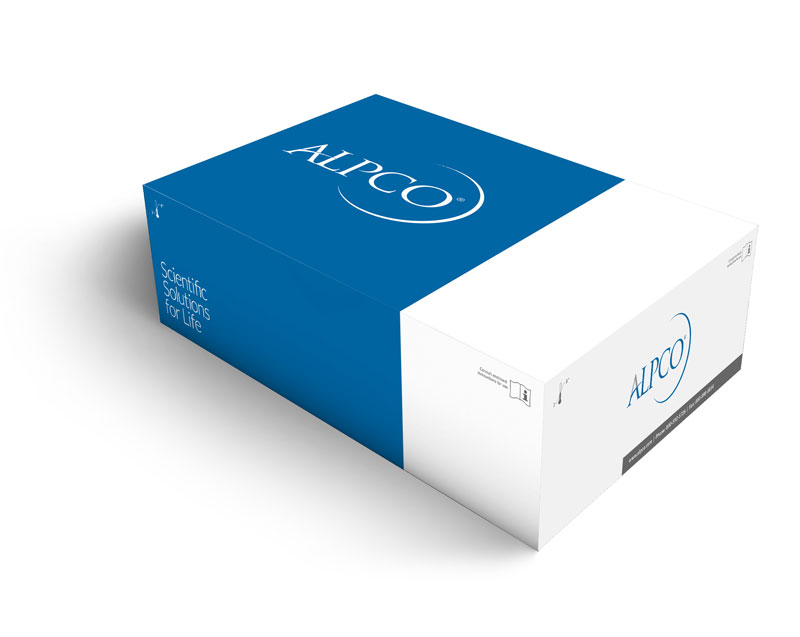-
 Estrone ELISA (Saliva)
Estrone ELISA (Saliva)Catalog #: 20-ESRHU-E01-SLV
Sensitivity: 10 pg/mL
Range: 10-300 pg/mL
Sample Types: Saliva
Sample Size(s): 96 Wells
Detection: Colorimetric -
 Free Estriol ELISA
Free Estriol ELISACatalog #: 20-FE3HU-E01
Sensitivity: 0.075 ng/mL
Range: 0.3 - 40 ng/mL
Sample Types: Serum
Sample Size(s): 96 Wells
Detection: Colorimetric -
 Human Placental Lactogen ELISA (HPL ELISA)
Human Placental Lactogen ELISA (HPL ELISA)Catalog #: 20-HPLHU-E01
Sensitivity: 0.3 mg/L
Range: 1.25 - 20 mg/L
Sample Types: Serum
Sample Size(s): 96 Wells
Detection: Colorimetric -
 Dehydroepiandrosterone ELISA (DHEA ELISA)
Dehydroepiandrosterone ELISA (DHEA ELISA)Catalog #: 20-DHEHU-E01
Sensitivity: 0.194 ng/mL
Range: 0.129 - 30 ng/mL
Sample Types: Citrate Plasma, Serum
Sample Size(s): 96 Wells
Detection: Colorimetric -
 6-Sulfatoxymelatonin ELISA
6-Sulfatoxymelatonin ELISACatalog #: 12-EK-M6S-U
Sensitivity: 0.14 ng/mL
Range: 0.8 - 40 ng/mL, adjusted for dilution
Sample Types: Urine
Sample Size(s): 96 Wells
Detection: Colorimetric -
 Melatonin ELISA
Melatonin ELISACatalog #: 12-MLTN-96-U
Sensitivity: 0.70 pg/mL
Range: 0.70 - 50 pg/mL
Sample Types: Saliva
Sample Size(s): 96 Wells
Detection: Colorimetric -
 Plasma/Serum Melatonin ELISA
Plasma/Serum Melatonin ELISACatalog #: 12-MLTN-PL-U
Sensitivity: 0.70 pg/mL
Range: 0.70 - 50 pg/mL
Sample Types: Plasma, See Package Insert, Serum, Urine
Sample Size(s): 96 Wells
Detection: Colorimetric -
 Direct Saliva Melatonin ELISA
Direct Saliva Melatonin ELISACatalog #: 12-EK-DSM-U
Sensitivity: 0.47 pg/mL.
Range: 0.5 - 50 pg/mL
Sample Types: Saliva
Sample Size(s): 96 Wells
Detection: Colorimetric -
 Anti-HAV ELISA
Anti-HAV ELISACatalog #: 22-HAVHU-E01
Sensitivity: 0.1 IU/mL
Range: 3 -50 mIU/ml
Sample Types: Plasma, Serum
Sample Size(s): 96 Wells
Detection: Colorimetric -
 Free Triiodothyronine ELISA (Free T3 ELISA)
Free Triiodothyronine ELISA (Free T3 ELISA)Catalog #: 25-FT3HU-E01
Sensitivity: 0.05 pg/mL
Range: 0.9 - 19 pg/mL
Sample Types: Serum
Sample Size(s): 96 Wells
Detection: Colorimetric -
 Free Thyroxine ELISA (Free T4 ELISA)
Free Thyroxine ELISA (Free T4 ELISA)Catalog #: 25-FT4HU-E01
Sensitivity: 0.05 ng/dl
Range: 0.3 - 7.0 ng/dl
Sample Types: Serum
Sample Size(s): 96 Wells
Detection: Colorimetric -
 Luteinizing Hormone ELISA (LH ELISA) (Urine)
Luteinizing Hormone ELISA (LH ELISA) (Urine)Catalog #: 20-LHUHU-E01
Sensitivity: 0.287 mIU/mL
Range: 0.287-200 mIU/mL
Sample Types: Urine
Sample Size(s): 96 Wells
Detection: Colorimetric
